|
Location: Tabasco, Mexico. |
Grid Reference:
18� 06' 12" N, 94� 02' 25" W. |
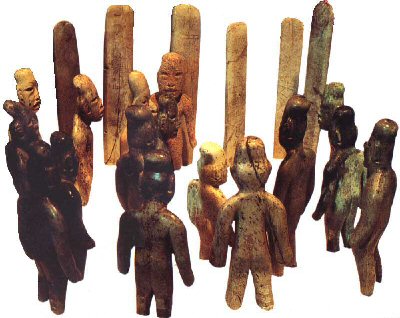
 La Venta:
(Ceremonial Olmec Centre).
La Venta:
(Ceremonial Olmec Centre).
La Venta was inhabited by people of the Olmec Culture from 1200
BC until 400 BC after which the site appears to have been abandoned. It
is believed to have been an
important civic and ceremonial centre. Today, the entire southern
end of the site is covered by a petroleum refinery and has been largely
demolished, making further excavations difficult or impossible.
(Click
here for a Map of the Site)
Although the earliest layer of occupation at La Venta dates to 1200 BCE, La
Venta did not reach its apogee until the decline of San Lorenzo, after 900 BCE.
After 500 years of pre-eminence, La Venta was all but abandoned by the beginning
of the fourth century BCE.
(2)
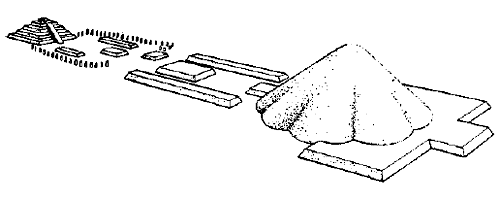
The La Venta pyramid complex.
Beneath the mounds and plazas were found a vast array of offerings and other
buried objects, more than 50 separate caches by one count, including buried Jade
celts, polished mirrors made of iron-ores, and five large "Massive Offerings" of
Serpentine blocks. It is estimated that 'Massive Offering 3' contains 50 tons of
carefully finished serpentine blocks, covered by 4,000 tons of clay fill.
(4)
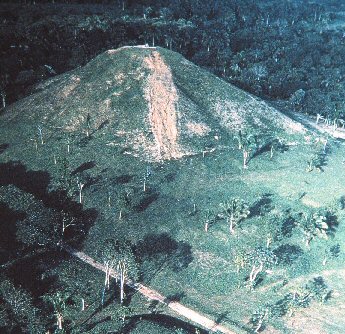
The Great Pyramid:
One of the earliest pyramids known in Mesoamerica, the Great Pyramid is
110 ft (33 m) high and contains an estimated 100,000 cubic meters of
earth fill. The current conical shape of the pyramid was once thought to
represent nearby volcanoes or mountains, but recent work by Rebecca
Gonzalez-Lauck has shown that the pyramid was originally a rectangular
pyramid with stepped sides and inset corners, and the current shape is
most likely due to 2500 years of erosion. The pyramid itself has never
been excavated, but a magnetometer survey in 1967 found an anomaly high
on the south side of the pyramid. Speculation ranges from a section of
burned clay to a cache of buried offerings to a tomb.
(Other Pre-Columbian pyramids)
What were once assumed
to be seven basalt "altars" were found
at La Venta. These
altars, roughly 2 meters high and twice as wide, feature an
elaborately dressed and sculpted figure on the centre front.
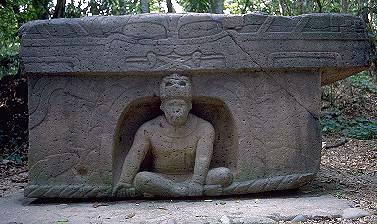
Photo: Altar 4.
It is now
believed that these altars are the record of a dynasty, with
each figure representing a ruler.
|
The La Venta Stone Heads: (An
African presence in Mexico..?)
Four heads were found at La
Venta, all of them faced the Atlantic, and the largest at 9ft
high had its domed top flattened so that it could function as an
altar.
The La Venta heads show several similarities to the Tres Zapotes
heads, which were discovered before them. It emerged that they
dominated the ceremonial plaza, a feature which suggests that
they were in some way 'revered'.
A speaking tube was found going in at the ear and out at the mouth; a
possible oracle or talking god. Radio
carbon dates from the site were published in 1957 and they give
an average reading of 814 BC +/- 134 yrs. These figures
were among the oldest at the La Venta site.
La Venta was not alone in its depiction
of Negroid faces in stone. Apart from the four found there, two were
excavated in Tres Zapotes and a further five at
San Lorenzo in Vera Cruz, one of
which, the largest known, is nine feet, four inches high, and is
estimated to weigh around 40 tons. (3)
The La Venta heads are thought
to have been carved by 700 BCE, but possibly as early as 850
BCE, while the San Lorenzo heads are credited to an earlier
period. The colossal heads can measure up to 9 ft 4 in. in
height and weigh several tons. The sheer size of the stones
causes a great deal of speculation on how the Olmecs were able
to move them. The major basalt quarry for the colossal heads at
La Venta was found at Cerro Cintepec in the Tuxtla Mountains,
over 80 km away. (1)
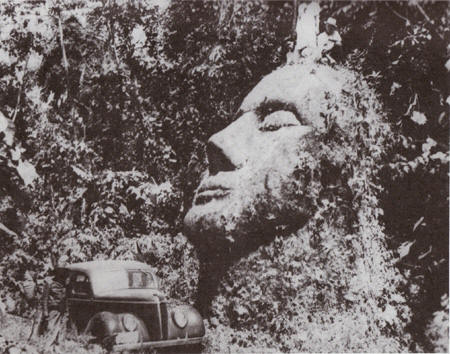
This Guatemalan Stone-head was
once a part of the great Monte Alto culture, which is believed
by some to have preceded the Olmec culture. It was unfortunately
destroyed in the process of removing it. The Monte Alto region
has also produced several stone heads, many of which have been
found to be naturally magnetic.
Of the
collection of "fat boy" sculptures from Monte Alto on display in
the town park of La Democracia, Guatemala and in front of its
local museum, four of the heads and three of the bodies were
found to have magnetic properties. All four of the heads have a
north magnetic pole located in their right temples, while three
of them have south magnetic poles below the right ear and the
fourth (that in front of the museum) has a south magnetic pole
in its left temple, Such a pattern of occurrence is unlikely to
be a matter of chance, even in a sample size as small as four.
(5)
(More about the Olmec Stone Heads)
(More about the Magnetic 'Fat-boys')
(Other Guatemalan Sites)
|
"La Venta Offering No. 4."

What appears to be a ceremony was
modelled and buried below the surface of a temple courtyard at some 3,000
years ago. Some unknown time after the initial burial, the site was opened
again through the courtyard floor (clearly, someone knew exactly where the
burial was located) and excavated to the level of the heads of the buried
figurines. After this "inspection", the offering was covered up again and
never opened again until recent time. Note the elongated skulls, a feature
which became common in several pre-Columbian cultures, noticeably in the
Paracas, Maya and Inca's.
(More
about Cranial Deformation)
|
Monument 19:
The earliest known example of a feathered serpent in the Americas.

This beautifully carved stone shows
what appears to be a person sitting on a feathered serpent. The
ceremonial nature of the site makes it likely that this representation
held an importance to the Olmecs, presumably symbolising an event or a
person. It is interesting to note that there have been suggestions that
La Venta was inhabited by people with old-world connections such as
representations of bearded people (which is a genetic trail absent from
native Americans), the large life-like stone heads with clearly Negriod
features (above), but it is interesting to note also the object being
held out by the hand...
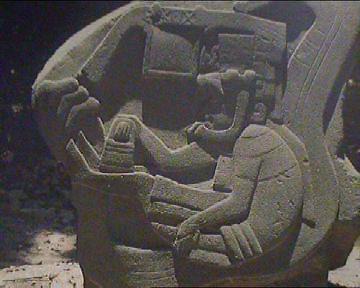
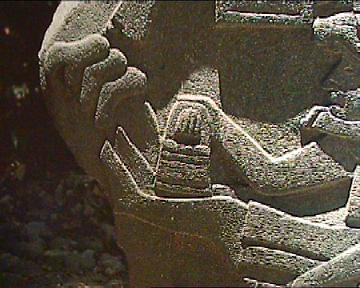
In consideration the of the theory forwarded by Van Sertima
(3) and others, that the 'Olmec'
site of La Venta was governed by Negroid Africans and Middle-eastern
Caucasians (between 800-600 BC), there is a strong case for the re-appraise the symbolism
behind this particular sculpture.
This same symbols appears
together in several Mesopotamian reliefs.
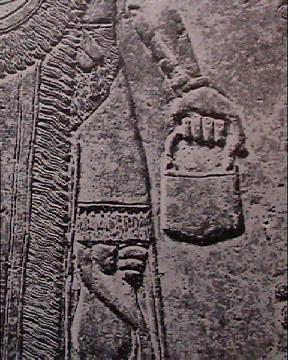
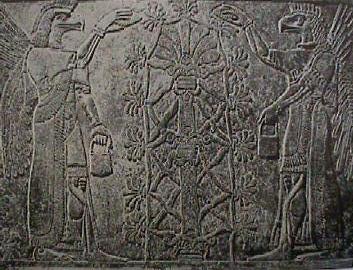

These 'Griffins' are from Nimrud, from the
time of Ashurnasirpal II, who opened his
great city in 879BC.
(In this frieze it appears that 'cobs'
are being 'harvested' from what is often referred to as the 'tree of
life'). It should be remembered that corn was a specifically new-world
plant.

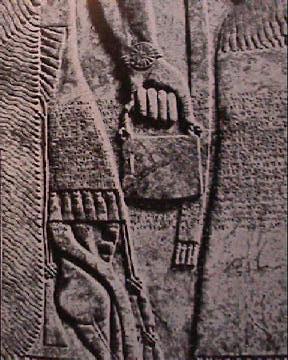
Another representation of a winged figure,
this time presenting the 'cob' to someone of importance in this Mesopotamian frieze...
(More
about Pre-Columbian contact between the Old-world and New-world
cultures)
|
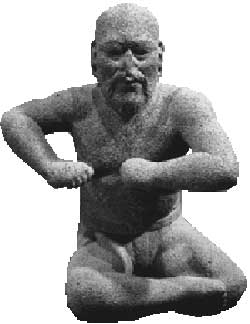
(Left): Statue of a bearded man from La
Venta.
Archaeo-astronomy
- On the archaeological site plan for La Venta it is easy to see how the site
is aligned slightly west, 8� west of north. Several other Mesoamerican sites
have this alignment, including San Jose Magote
|













